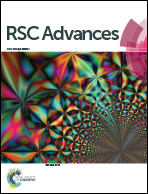Structural characterization and anti-inflammatory effect in hepatocytes of a galactoglucan from Antrodia camphorata mycelium†
Abstract
The galactoglucan ACP2 was isolated from cultured Antrodia camphorata mycelium through anion-exchange column chromatography and Sephadex G-100 chromatography and shown to exhibit hepatoprotective function in L02 cells. Based on monosaccharide composition analysis, ACP2 was mainly composed of glucose, galactose, and 6-deoxyglucose in a molar ratio of 5 : 2 : 1. The average molecular weight of ACP2 was 1.93 × 104 Da. The primary structure of ACP2 was elucidated with Fourier-transform infrared spectroscopy, gas chromatography-mass spectrometry, and nuclear magnetic resonance spectroscopy. The results indicated the following composition: →6)-linked-β-D-Galp-(1→, →6)-linked-α-D-Glcp-(1→, →3)-linked-α-D-Glcp-(1→, and →2,4)-linked-β-D-Glcp-(1→, with terminal 6-deoxy-α-D-Glcp and α-D-Glcp. ACP2 alleviated lipopolysaccharide-induced hepatocyte inflammation by down-regulating the expressions of COX-2, IL-1β, TNF-α and IL-6. The decreased expressions of TLR4, MyD88, NF-κB, and phosphorylated p38 in ACP2-treated L02 cells indicated that ACP2 might ameliorate inflammation through the TLR4 and p38/NF-κB signaling pathways.



 Please wait while we load your content...
Please wait while we load your content...